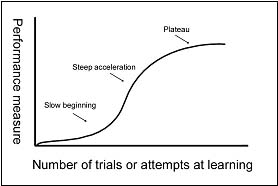Growth Phenomena
So far we have (metaphorically) walked up to a system, examined it, analyzed some parts, and perhaps identified a few distinctive patterns of behavior. These included goal-oriented behavior, explosions of positive feedback, or back and forth movements of oscillation.
Now we turn to growth processes. Recall that Bertalanffy proposed his concept of open systems to deal with problems in biology, where things grow and develop.
The concept of positive feedback is often relevant to growth processes. Any time a system departs from a previous steady state or equilibrium, that means some change or disturbance is being amplified, the marker of positive feedback.
A positive feedback process triggers growth and change. It must eventually be limited in some way, to prevent damage to the system. Uncontrolled growth, like cancer, kills the organism.
Therefore growth tends to follow a twofold process:
1) A disturbance is triggered and builds upon itself (deviation amplifying feedback).
2) A limit is reached or some resource is depleted, and the disturbance is reduced or concluded.
Fractal growth patterns, described earlier, fit this pattern. Recall that a pattern is called fractal if the same routine is applied repeatedly (an iterative process) resulting in accumulation of smaller units into a larger structure.
As a snail grows its shell, it lays down layer after layer of material. That is an iterative growth process. Eventually the shell is completed, and the process is stopped.
Hives of insects and nests of birds are built with a similar repetition of small routines: they gather material and add it to the nest in ways guided by instinct, until a genetically guided signal indicates the structure is complete.
The system detects goal completion and terminates the growth. That is a part of every growth process, because uncontrolled growth is usually fatal.
Chemicals called growth hormones produce human growth. If no growth hormone is produced, the child will not grow. If growth hormone is never turned off, the result is gigantism.
The S-curve of Growth
Normally a child grows slowly at first, experiences a growth spurt around adolescence, and then stops growing in adulthood. Plotted on a graph, this appears as an S shaped curve. It starts slowly, accelerates during the growth spurt, then levels off.
S-curves are very common in growth processes. An example is the learning curve. This can be found in most cases of skill learning.
Consider the progress of a human learning to use a keyboard. The first step is learning where the keys are. This beginning phase can be slow, so the learning curve (which measures performance) rises slowly.

A typical S curve of growth
After a while, basic components of the skill become familiar. Motor coordination improves. The individual starts to practice multiple keystrokes. Things fall into place.
This is the ascending phase of the S curve (time is on the horizontal x axis and some measure of performance is on the vertical y axis). Ideally, enjoyment of using the new skill makes it improve even faster, a positive feedback process.
However, no skill improves forever. Eventually the learner reaches a limit, and further practice does not produce as much improvement.
The keyboardist reaches peak speed, or the musician hits a plateau or flat spot in development. Then progress halts or slows. The result is the last part of the S-curve, where the accelerating change levels off.
Principle of the S curve of growth: Systems grow through positive feedback until resources become limited, producing an S curve of growth.
Business and marketing majors recognize the S-curve as typical of sales growth in a newly opened market. When a new product is first introduced, sales may be slow.
As people find out about the product and its reputation spreads, demand may build. Sales may accelerate rapidly for a time in a positive feedback pattern, but this cannot continue forever.
Eventually market saturation occurs. Most of the potential customers for the product already own it.
This ends the rapid growth phase. The S-curve of growth levels off (if there is continuing steady demand) or falls (if there is less demand).
Write to Dr. Dewey at psywww@gmail.com.
Search Psych Web including the General Systems Toolkit and the online textbook Psychology: An Introduction below.
Copyright © 2017 Russ Dewey
